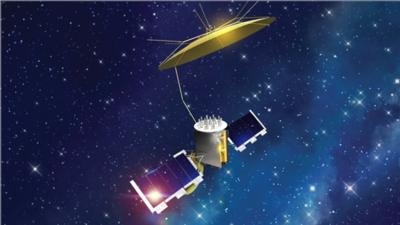Satellite Completes U.S. Navy's New Global Military Cellular Network
The Naval Spacecraft Operations Control facility at Naval Base Ventura County in California is talking with the fifth Mobile User Objective System (MUOS-5) satellite in space after its successful launch last week. Built by Lockheed Martin, MUOS-5 completes the U.S. Navy’s satellite constellation that will provide a new global military cellular network offering enhanced communications capabilities for mobile forces.

The MUOS-5 satellite launched at 8:30 a.m. EDT this morning aboard a United Launch Alliance Atlas V rocket from Cape Canaveral Air Force Station, Florida. A Lockheed Martin-led initialization team, stationed at Naval Base Ventura County, Point Mugu, California, is operating the satellite from its transfer orbit to its test slot.
Over the next few days, MUOS-5 will transition to reach its geosynchronous orbit location approximately 22,000 miles above the Earth. The satellite’s solar arrays and antennas will then be deployed, and on-orbit testing will start for subsequent turn-over to the Navy for test and commissioning to service.
The Navy's Program Executive Office for Space Systems and its Communications Satellite Program Office responsible for the MUOS program are based in San Diego. Lockheed Martin assembled and tested all five now-on-orbit MUOS satellites at its Sunnyvale, California, facility.
For the Navy, MUOS-5 completes a network of orbiting satellites and relay ground stations that is revolutionizing secure communications for mobile military forces. Users with MUOS terminals will be able to seamlessly connect beyond line-of-sight around the world and into the Global Information Grid, as well as into the Defense Switching Network. MUOS’ capabilities include simultaneous, crystal-clear voice, video and mission data over a secure high-speed Internet Protocol-based system.

“The launch of MUOS-5 is a major milestone. MUOS will be a game changer in communications for our service men and women on the front lines around the world,” said Mark Woempner, director of Narrowband Communications Systems at Lockheed Martin. “Now that the Navy’s constellation is complete, we will continue to work with our government and industry teammates to further refine MUOS based on user feedback. We are committed to bringing all of MUOS’ advanced capabilities to our warfighters.”
The MUOS network provides near-global coverage, including communications reach deep into polar regions . Once fully operational, the network will provide users with 16 times more communications capacity than the legacy system it will eventually replace.
Like its predecessors, the MUOS-5 satellite has two payloads to support both new Wideband Code Division Multiple Access (WCDMA) waveform capabilities, as well as the legacy Ultra High Frequency (UHF) satellite system. On orbit, MUOS-5 will augment the constellation as a WCDMA spare, while actively supporting the legacy UHF system, currently used by many mobile forces today.
Lockheed Martin invited six students to watch the MUOS-5 launch. Earlier this year, the students competed in the FIRST Robotics Competition and the FIRST Tech Challenge and were Dean’s List winners from each of the three Florida FIRST championship events. The students met Lockheed Martin’s launch team, where they showcased their robots and later attended a photo opportunity to see the Atlas V rocket up close before the launch.
(Images provided with Lockheed Martin news release)
 ANN's Daily Aero-Term (04.26.24): DETRESFA (Distress Phrase)
ANN's Daily Aero-Term (04.26.24): DETRESFA (Distress Phrase) ANN's Daily Aero-Linx (04.26.24)
ANN's Daily Aero-Linx (04.26.24) Airborne 04.22.24: Rotor X Worsens, Airport Fees 4 FNB?, USMC Drone Pilot
Airborne 04.22.24: Rotor X Worsens, Airport Fees 4 FNB?, USMC Drone Pilot Airborne 04.24.24: INTEGRAL E, Elixir USA, M700 RVSM
Airborne 04.24.24: INTEGRAL E, Elixir USA, M700 RVSM Airborne-NextGen 04.23.24: UAVOS UVH 170, magni650 Engine, World eVTOL Directory
Airborne-NextGen 04.23.24: UAVOS UVH 170, magni650 Engine, World eVTOL Directory




